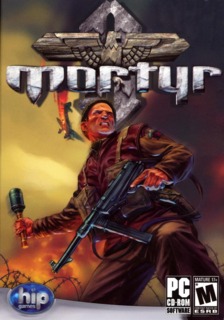Mortyr 2 is a huge improvement over the original and a fairly entertaining experience in its own right...
Mortyr 2 reflects a marked improvement over the earlier title, with a less convoluted storyline and a more satisfying combat model. The graphics engine can render both massive landscapes and proximate details very well, with only a few framerate drops on my mid-range rig. I especially enjoyed the snowy, aurora-tinged fields of northern Europe and the idyllic, vibrant meadows of Yugoslavia for the scenery, and the uphill battle outside of the monastery for its tricky and bloody firefights. One major gripe I discovered in M2’s combat mechanics had to do with its grenades, which produced an astonishingly high degree of damage within a huge blast radius. The grenades were difficult to both see and hear – the only sure way to prepare for the heavy-duty impairment they promised was to actually witness a German soldier in the act of throwing one, or to simply keep moving in an erratic pattern – so I repeatedly found myself blown skyward without any warning. The grenade issue was a double-edged sword, however; my opponents were just as susceptible to their concussive charms, so I used the potato-mashers more in Mortyr 2 than in any other WWII-style game and never found myself wanting for supplies.
M2’s rail-based segments were a mixed bag. Although Sven’s improbable laps around some German barracks in the back of a stolen Volkswagen rigged with an MG-34 were a lot of destructive fun, the (thankfully optional) ride aboard an incredibly fragile ultralight whirlybird was a poorly-realized joke. Other scenarios like Sven’s scramble through enemy trenches in the midst of a deafening standoff on the eastern front and the close-quarters exchange of lead in the otherwise mellow candlelit monastery were a lot of fun and a far, far cry from the wretched, blind luck-fueled clashes that tainted the original Mortyr.
I don’t recall Mortyr 2’s initial MSRP, but I nabbed it from the bargain bin for $15 shortly after its release last year. Although the game is appropriately sized for its low-end cost with only 11 levels, almost every area is huge and requires roughly forty-five minutes to an hour to cover thoroughly (more if you don’t watch out for the stealthy and catastrophic grenades). This title is recommended for anyone who truly loves shooters whatever their milieu, particularly for any players who scorched their central nervous system while stumbling unhappily through the original in 1999, as Sven’s exploits do much to restore honor to the Mortyr family name.

